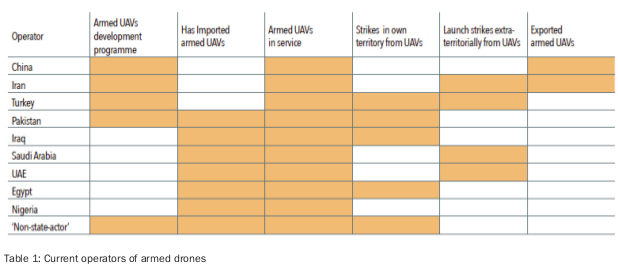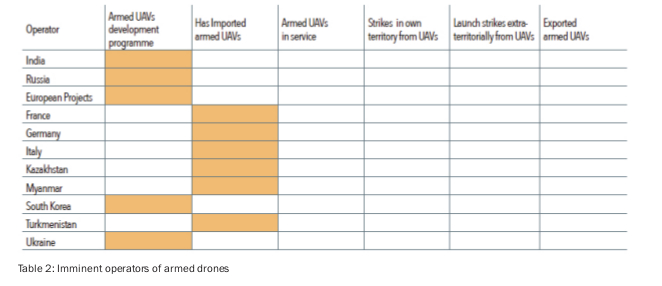From an obscure technology originally used for target practice, drones have become almost central to the way in which armed forces fight wars and project power in the early 21st century.
The US and Israel played a leading role in the development and use of remote-controlled unmanned aerial vehicles (UAVs), commonly called drones. Both countries have manufactured and operated unarmed and armed systems since the early 2000s. While these two nations monopolised the field for more than a decade, today an increasing number of countries manufacture a startling array of military drones, from giant systems that fly at vast heights to tiny hand-held devices designed to investigate the interiors of buildings.


A second generation
The new report, Drone Wars: The Next Generation, from Drone Wars UK focuses on the development and use of armed drones (such as the Predator and Reaper) by the countries that make up a ‘second generation’ of armed drone producers and operators (beyond the US, UK and Israel).
Inevitably, due to the secrecy surrounding the use of military systems, as well as the fast-changing pace of drone wars, it is difficult to be sure we have captured a complete picture. Nevertheless, after sifting through rumour, hearsay, hype and propaganda, we believe our report gives a clear snapshot of the current operators of armed drones.
While there are some countries on the verge of bringing armed drones into service, either through development programmes or through acquisitions, our research shows this second generation currently consists of nine state operators and several non-state actors (NSAs) and our report outlines the development programmes, acquisitions, deployment and export of armed drones for this group.
Although some may be surprised at the absence of Russia and India from our list of active operators, their development programmes have not yet resulted in the production of fully functional systems. Iran and Turkey have had more success in their programmes and are already using several models of armed drone in combat situations. China has an extensive development programme of unmanned systems with several companies working on development programmes in this area. Moreover, there are also a number of countries actively using armed drones that they have acquired from China.
While different in significant ways, we have also included 'non-state actors' as some, at least, have developed fairly sophisticated armed drones beyond the commercial off-the-shelf 'IED' ('improvised explosive device' or roadside bomb)-type device.
By way of completeness, we also examine in brief those countries likely to join the second wave in the near future, as advanced drone programmes are ongoing and likely to come to fruition soon.
In summary, after the US, UK and Israel, the 10 operators that we cover (nine states plus NSAs) who are actively using armed drones will soon be joined by a further 11 states that are developing or acquiring armed drones. This will almost double the number of current operators of armed drones and makes ever more urgent the need for controls on use and proliferation.

Controls needed
The growing number of operators, alongside the complex legal and ethical issues raised by the use of armed drones, highlights the urgent need for clear international controls.
The increasing export of armed drones by this second generation (by China in particular) also calls into question whether current international proliferation controls are fit for purpose. Since China began exporting armed drones, the US drone lobby in particular has been pushing hard for international and domestic controls to be ‘relaxed.’
In April, the US published a new domestic arms export policy which eased some restrictions on the export of armed drones but did not go as far as the US drone industry wanted. Trump administration officials, however, indicated they would continue to work to amend international controls to further reduce restrictions on the export of armed drones.
With the numbers of states using armed UAVs likely to double in the near future and with more drones available for export, the need for effective control on the proliferation of armed drones, as well as the need for an ethical and legal framework for use, is more important now than ever.

